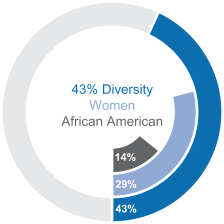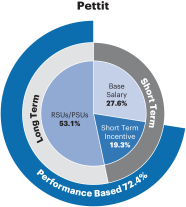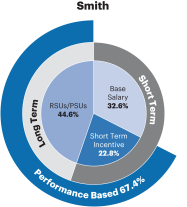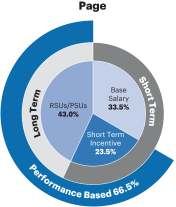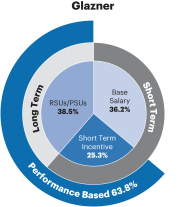| (a) | total stockholder return; |
| (b) | such total stockholder return as compared to total return (on a comparable basis) of a publicly available index such as, but not limited to, the Standard & Poor’s 500 Stock Index; |
| (e) | earnings before interest expense, taxes, depreciation and amortization; |
| (f) | earnings before interest expense, taxes, depreciation and amortization and before bonuses, service fees, and extraordinary or special items; |
| (g) | pretax operating earnings after interest expense and before bonuses, service fees, and extraordinary or special items; |
| (p) | ratio of debt to stockholders’ equity; |
Any performance measure(s) may be used to measure (i) the performance of the Company, a subsidiary, and/or an affiliate as a whole, (ii) the Company, any subsidiary, and/or any other affiliate or any combination, or (iii) any business unit of the Company, subsidiary, and/or affiliate or any combination thereof, as the Compensation Committee may deem appropriate. The Company may also use any of the above performance measures as compared to the performance of a group of comparator companies, or published or special index that the Compensation Committee, deems appropriate. The Company may also select performance measure (j) above as compared to various stock market indices. The Compensation Committee has the authority to provide for accelerated vesting of any award based on the achievement of performance goals pursuant to the performance measures specified above.
Award Limits.
Awards under the 2011 Plan are subject to the following limits:
The maximum number of shares of Company common stock subject to options or stock appreciation rights (“SARs”) that can be awarded under the 2011 Plan to any person is 750,000per calendar year; provided, however, that the maximum number of shares of Company common stock subject to options or SARs that can be granted under the 2011 Plan to any person in the year that the person is first employed by the Company, or any affiliate, is 1,000,000.
The maximum number of shares that can be granted under the 2011 Plan to any person, other than pursuant to options or SARs, is 500,000 per calendar year; provided, however, that the maximum number of shares of Company common stock subject to awards other than options or SARs that can be granted under the 2011 Plan to any person in the year that the person is first employed by the Company, or any affiliate, is 600,000.
The maximum amount that may be paid as a performance-based cash-settled award in a 12-month performance period to any person is $2,500,000 and the maximum amount that may be paid as performance-based cash-settled awards in respect of a performance period greater than 12 months by any person is $5,000,000.
The preceding limitations are subject to adjustment for stock dividends and similar events as provided in the 2011 Plan.
It is not possible to determine the actual amount of compensation that will be earned under the 2011 Plan in 2016 or in future years because the awards earned will depend on future performance as measured against the applicable performance goals established by the Compensation Committee. The Company expects that future awards under the 2011 Plan will be granted in a manner substantially consistent with the historical grant of awards under the 2011 Plan. For information regarding past grants and outstanding equity awards, see the disclosure in this Proxy Statement in “Grants of Plan-Based Awards” and “Outstanding Equity Awards at 2015 Fiscal Year-End.”
Other Features of the 2011 Plan
Administration
Except as the Board may otherwise determine, the committee appointed by the Board to administer the 2011 Plan must consist of two or more directors of the Company who: (a) are not officers or employees of the Company, (b) qualify as “outside directors” within the meaning of Section 162(m) of the Internal Revenue Code, (c) meet such other requirements as may be established from time to time by the SEC for plans intended to qualify for exemption under Rule 16b-3 (or its successor) under the Exchange Act and (d) comply with the independence requirements of the stock exchange on which the our common stock is listed. The 2011 Plan is currently administered by the Compensation Committee of the Board of Directors. Subject to the terms of the 2011 Plan, the Compensation Committee selects participants to receive awards, determines the types of awards and terms and conditions of awards, and interprets provisions of the 2011 Plan. Members of the Compensation Committee serve at the pleasure of the Board of Directors. The Board may also appoint one or more separate committees of the Board, each composed of one or more directors of the Company who may also be officers or employees of the Company, to administer the Plan with respect to employees or other service providers who are not executive officers or directors of the Company.
Common Stock Reserved for Issuance under the 2011 Plan
The shares of common stock reserved for issuance under the 2011 Plan consists of authorized but unissued shares or treasury shares or any combination thereof.
Share Usage
Under the terms of the 2011 Plan, any shares of our common stock that are subject to awards are counted against the 2011 Plan share limit as one share for every one share subject to the award. Shares subject to awards granted under the 2011 Plan or the 2007 Omnibus Incentive Plan, as amended (the “2007 Plan”) that terminate by expiration, forfeiture, cancellation, or which are settled in cash in lieu of shares or are exchanged prior to the issuance of shares for awards not involving shares shall be available again for grant under the 2011 Plan. Any shares tendered to pay the option price of an option granted under the 2011 Plan or the 2007 Plan or to satisfy tax withholding obligations associated with an award granted under either plan, shall become available again for grant under the 2011 Plan. Any shares that were subject to a SAR granted under the 2011 Plan that were not issued upon the exercise of such SAR shall become available again for grant under the 2011 Plan.
Amendment or Termination of the 2011 Plan
The Board of Directors may terminate, suspend, or amend the 2011 Plan at any time and for any reason as to any shares as to which awards have not been made. The 2011 Plan will terminate in any event ten years after the effective date of the 2011 Plan, which will be May 19, 2021. Amendments must be submitted for stockholder approval to the extent stated by the Board, required by applicable law or required by applicable stock exchange listing requirements. In addition, no amendment may be made to the no-repricing provisions described below without the approval of the Company’s stockholders.
No-Repricing
Under the 2011 Plan, except in connection with certain corporate transactions, no amendment or modification may be made to an outstanding stock option or SAR, including, without limitation, by replacement of stock options or SARs with another award type, that would be treated as a repricing under the rules of the stock exchange on which our common stock is listed or would replace stock options or SARs with cash, in each case, without the approval of the stockholders provided, that, appropriate adjustments may be made to outstanding stock options and SARs to achieve compliance with applicable law, including the Internal Revenue Code.
Option
The 2011 Plan permits the granting of options to purchase shares of our common stock intended to qualify as incentive stock options under the Internal Revenue Code and stock options that do not qualify as incentive stock options. The exercise price of each stock option may not be less than 100% of the fair market value of our common stock on the date of grant date. The fair market value is generally determined as the closing price of the common stock on the grant date or other determination date. In the case of certain 10% stockholders who receive incentive stock options, the exercise price may not be less than 110% of the fair market value of the common stock on the date of grant. An exception to these requirements is made for options that the Company grants in substitution for options held by employees of companies that the Company acquires. In such a case the exercise price is adjusted to preserve the economic value of the employee’s stock option from his or her former employer.
The term of each stock option is fixed by the Compensation Committee and may not exceed ten years from the date of grant (five years if the optionee is a 10% stockholder and the option is intended to be an incentive stock option). The Compensation Committee determines at what time or times each option may be exercised and the period of time, if any, after retirement, death, disability or termination of employment during which options may be exercised. Options may be made exercisable in installments. The exercisability of options may be accelerated by the Compensation Committee.
In general, an optionee may pay the exercise price of an option by cash or cash equivalents, or, if the option agreement so provides, by tendering shares of our common stock with a fair market value equal to the option exercise price, by means of a broker-assisted cashless exercise or, any combination thereof. An award agreement may provide for other methods as well.
Other Awards
Under the 2011 Plan, the following types of awards may also be made:
SARs. A SAR is an award that gives the holder the right to receive, upon exercise thereof, the excess of (a) the fair market value of one share of our common stock on the date of exercise over (b) the SAR exercise price on the grant date. The SAR exercise price must be at least equal to the fair market value of a share of our common stock on the date of grant, as determined in accordance with the 2011 Plan.
Restricted Stock. Restricted stock is an award of shares of our common stock, which may be granted for no consideration (other than the par value of the shares which is deemed paid by services). At the time a grant of restricted stock is made, the Compensation Committee may establish a period of time applicable to such restricted stock. The Compensation Committee also may, at the time of grant, prescribe restrictions in addition to or other than the expiration of the restricted period, including the satisfaction of corporate or individual performance objectives, applicable to all or any portion of the award of restricted stock. There is a minimum three-year vesting requirement for time-vested restricted stock awards and deferred stock unit awards and one-year minimum vesting requirement for performance-vesting restricted stock awards and deferred stock unit awards, with up to ten percent of shares reserved for issuance under the plan carved-out from the foregoing minimum requirements. Further, the foregoing limitation does not apply to any dividends or dividend equivalent rights, or other distributions, issued in connection with any award granted at any time under the 2011 Plan.
Unless the Compensation Committee provides otherwise in the award agreement, holders of restricted stock will have the right to vote such stock and the right to receive any dividends declared or paid with respect to such stock. The Compensation Committee may provide that any dividends paid on restricted stock must be reinvested in shares of our common stock, which may or may not be subject to the same vesting conditions and restrictions applicable to the restricted stock.
Unrestricted Stock. An award of unrestricted stock is an award of shares of our common stock free of restrictions. The Compensation Committee may grant (or sell at par value or such other higher purchase price determined by the Compensation Committee) an award of shares of unrestricted stock under the 2011 Plan. Unrestricted stock awards may be granted or sold as described in the preceding sentence in respect of services and other valid consideration, or in lieu of, or in addition to, any cash compensation due to the grantee.
Deferred Stock Units. A stock unit is a bookkeeping entry that represents the equivalent of one share of Company common stock. The same terms and restrictions as may be set forth by the Compensation Committee with respect to shares of restricted stock apply to deferred stock units. However, holders of deferred stock units will have no rights as stockholders or any other rights (other than those of a general creditor of the Company). The Compensation Committee may provide that the holder of deferred stock units will be entitled to receive, upon the Company’s payment of a cash dividend on its outstanding common stock, a cash payment for each stock unit held equal to the per-share dividend paid on our common stock. The Compensation Committee may also provide in the award agreement that such cash payment will be deemed reinvested in additional deferred stock units at a price per unit equal to the fair market value of a share of Company common stock on the date that such dividend is paid.
Dividend Equivalent Rights. A dividend equivalent right is an award entitling the recipient to receive credits based on cash distributions that would have been paid on the shares of our common stock specified in the dividend equivalent right (or other award to which it relates) if such shares had been issued to and held by the recipient. The terms and conditions of dividend equivalent rights will be specified in the grant. Except as may otherwise be provided by the Compensation Committee either in the award Agreement, in another agreement with the recipient, or in writing after the award agreement is issued, a recipient’s rights in all dividend equivalent rights will automatically terminate upon the recipient’s termination of service for any reason.
Performance-Based Awards. These awards are awards of options, SARs, restricted stock, deferred stock units, performance shares or other equity-based awards made subject to the achievement of performance goals over a performance period specified by the Compensation Committee and that comply with applicable law. Subject to the terms of the 2011 Plan, the Compensation Committee may pay earned shares or units in cash or in shares of our common stock (or in a combination of cash and shares of our common stock) equal to the value of the earned common stock or units at the close of the applicable performance period or as soon as practicable thereafter. Performance-based awards to individuals who are covered under Section 162(m) of the Internal Revenue Code, or who the Compensation Committee designates as likely to be covered in the future, will comply with the requirement that payments to such employees qualify as performance-based compensation under Section 162(m) of the Internal Revenue Code (as described below) to the extent that the Compensation Committee so designates. Such employees include the chief executive officer and the three highest compensated executive officers (other than the chief financial officer) determined at the end of each year (the “covered employees”).
Recoupment
Award agreements for awards granted pursuant to the 2011 Plan may be subject to mandatory repayment by the recipient to the Company of any gain realized by the recipient to the extent the recipient is in violation of or in conflict with certain agreements with the Company (including but not limited to an employment or non-competition agreement). The Company may also annul an award if the recipient is an employee and is terminated for Cause as defined in the applicable award agreement, the 2011 Plan, or any other agreement with the Company.
Any award granted pursuant to the 2011 Plan shall be subject to mandatory repayment to the extent the recipient is, or in the future becomes, subject to any Company “clawback” or recoupment policy that requires the repayment to the Company of compensation paid to by the Company or an affiliate in the event that such recipient fails to comply with, or violates, the terms or requirements of such policy.
If the Company is required to prepare an accounting restatement due to the material noncompliance of the Company, as a result of misconduct, with any financial reporting requirement under the securities laws, a recipient subject to automatic forfeiture under Section 304 of the Sarbanes-Oxley Act of 2002 and any recipient who knowingly engaged in the misconduct, was grossly negligent in engaging in the misconduct, knowingly failed to prevent the misconduct or was grossly negligent in failing to prevent the misconduct, shall reimburse the Company the amount of any payment in settlement of an award earned or accrued during the 12-month period following the first public issuance or filing with the United States Securities and Exchange Commission (whichever first occurred) of the financial document that contained such material noncompliance.
Notwithstanding any other provision of the 2011 Plan or any provision of any award agreement, if the Company is required to prepare an accounting restatement, the recipient shall forfeit any cash or stock received in connection with an award (or an amount equal to the fair market value of such stock on the date of delivery thereof to the recipient if the recipient no longer holds the common stock) if, pursuant to the terms of the award agreement for such award, the amount of the award earned or the vesting in the award was expressly based on the achievement of pre-established performance goals set forth in the award agreement (including earnings, gains, or other performance goals) that are later determined, as a result of the accounting restatement, not to have been achieved.
Effect of Certain Corporate Transactions
Certain change of control transactions involving us, such as a sale of the Company, may cause awards granted under the 2011 Plan to vest, unless the awards are continued or substituted for in connection with the change of control transaction.
Adjustments for Stock Dividends and Similar Events
The Compensation Committee will make appropriate adjustments in outstanding awards and the number of shares available for issuance under the 2011 Plan, including the individual limitations on awards, to reflect stock splits and other similar events.
Section 162(m) of the Internal Revenue Code
Section 162(m) of the Internal Revenue Code limits publicly-held companies such as the Company to an annual deduction for federal income tax purposes of $1 million for compensation paid to their covered employees. However, performance-based compensation is excluded from this limitation. The 2011 Plan is designed to permit the Compensation Committee to grant stock options and stock appreciation rights that qualify as performance-based for purposes of satisfying the conditions of Section 162(m).
To qualify as performance-based:
| (i) | the compensation must be paid solely on account of the attainment of one or more pre-established, objective performance goals; |
| (ii) | the performance goal under which compensation is paid must be established by a compensation committee comprised solely of two or more directors who qualify as outside directors for purposes of the exception; |
| (iii) | the material terms under which the compensation is to be paid must be disclosed to and subsequently approved by stockholders of the corporation before payment is made in a separate vote; |
| (iv) | the performance goals must be established not later than the earlier of (a) 90 days after the beginning of any performance period applicable to the award and (b) the day on which 25% of any performance period applicable to the award has expired, or at such other date as may be required or permitted for “performance-based compensation” under Section 162(m) of the Internal Revenue Code; and |
| (v) | the Compensation Committee must certify in writing before payment of the compensation that the performance goals and any other material terms were in fact satisfied. |
In the case of compensation attributable to stock options, the performance goal requirement (summarized in (i) above) is deemed satisfied, and the certification requirement (summarized in (v) above) is inapplicable, if the grant or award is made by the Compensation Committee; the 2011 Plan under which the option is granted states the maximum number of shares with respect to which options may be granted during a specified period to an employee; and under the terms of the option, the amount of compensation is based solely on an increase in the value of the Company’s common stock after the date of grant.
Under the Internal Revenue Code, a director is an “outside director” of the Company if he or she is not a current employee of the Company; is not a former employee who receives compensation for prior services (other than under a qualified retirement plan); has not been an officer of the Company; and does not receive, directly or indirectly (including amounts paid to an entity that employs the director or in which the director has at least a five percent ownership interest), remuneration from the Company in any capacity other than as a director.
Federal Income Tax Consequences
Non-Qualified Options
The grant of an option is not a taxable event for the grantee or the Company. Upon exercising a non-qualified option, a grantee will recognize ordinary income in an amount equal to the difference between the exercise price and the fair market value of the Company common stock on the date of exercise. Upon a subsequent sale or exchange of shares acquired pursuant to the exercise of a non-qualified option, the grantee will have taxable capital gain or loss, measured by the difference between the amount realized on the disposition and the tax basis of the shares of Company common stock (generally, the amount paid for the shares plus the amount treated as ordinary income at the time the option was exercised).
If we comply with applicable reporting requirements and with the restrictions of Section 162(m) of the Internal Revenue Code, we will be entitled to a business expense deduction in the same amount and generally at the same time the grantee recognizes ordinary income.
A grantee who has transferred a non-qualified stock option to a family member by gift will realize taxable income at the time the non-qualified stock option is exercised by the family member. The grantee will be subject to withholding of income and employment taxes at that time. The family member’s tax basis in the shares of Company common stock will be the fair market value of the shares of Company common stock on the date the option is exercised. The transfer of vested non-qualified stock options will be treated as a completed gift for gift and estate tax purposes. Once the gift is completed, neither the transferred options nor the shares acquired on exercise of the transferred options will be includable in the grantee’s estate for estate tax purposes.
In the event a grantee transfers a non-qualified stock option to his or her ex-spouse incident to the grantee’s divorce, neither the grantee nor the ex-spouse will recognize any taxable income at the time of the transfer. In general, a transfer is made “incident to divorce” if the transfer occurs within one year after the marriage ends or if it is related to the end of the marriage (for example, if the transfer is made pursuant to a divorce order or settlement agreement). Upon the subsequent exercise of such option by the ex-spouse, the ex-spouse will recognize taxable income in an amount equal to the difference between the exercise price and the fair market value of the shares of Company common stock at the time of exercise. Any distribution to the ex-spouse as a result of the exercise of the option will be subject to employment and income tax withholding at this time.
Incentive Stock Options
The grant of an option is not a taxable event for the grantee or for the Company. A grantee will not recognize taxable income upon exercise of an incentive stock option (except that the alternative minimum tax may apply), and any gain realized upon a disposition of the Company common stock received pursuant to the exercise of an incentive stock option will be taxed as long-term capital gain if the grantee holds the shares of Company common stock for at least two years after the date of grant and for one year after the date of exercise (the “holding period requirement”). We will not be entitled to any business expense deduction with respect to the exercise of an incentive stock option, except as discussed below.
For the exercise of an option to qualify for the foregoing tax treatment, the grantee generally must be our employee or an employee of our subsidiary from the date the option is granted through a date within three months before the date of exercise of the option.
If all of the foregoing requirements are met except the holding period requirement mentioned above, the grantee will recognize ordinary income upon the disposition of the Company common stock in an amount generally equal to the excess of the fair market value of the Company common stock at the time the option was exercised over the option exercise price (but not in excess of the gain realized on the sale). The balance of the realized gain, if any, will be capital gain. We will be allowed a business expense deduction to the extent the grantee recognizes ordinary income, subject to our compliance with Section 162(m) of the Internal Revenue Code and to certain reporting requirements.
SARs
There are no immediate tax consequences of receiving an award of SARs that is settled in Company common stock under the 2011 Plan. Upon exercising a SAR that is settled in Company common stock, a grantee will recognize ordinary income in an amount equal to the difference between the exercise price and the fair market value of the Company common stock on the date of exercise. If we comply with applicable reporting requirements and with the restrictions of Section 162(m) of the Internal Revenue Code, we will be entitled to a business expense deduction in the same amount and generally at the same time as the grantee recognizes ordinary income.
Restricted Stock
A grantee who is awarded restricted stock will not recognize any taxable income for federal income tax purposes in the year of the award, provided that the shares of Common Stock are subject to restrictions (that is, the restricted stock is nontransferable and subject to a substantial risk of forfeiture). However, the grantee may elect under Section 83(b) of the Internal Revenue Code to recognize compensation income in the year of the award in an amount equal to the fair market value of the Company common stock on the date of the award (less the purchase price, if any), determined without regard to the restrictions. If the grantee does not make such a Section 83(b) election, the fair market value of the Company common stock on the date the restrictions lapse (less the purchase price, if any) will be treated as compensation income to the grantee and will be taxable in the year the restrictions lapse and dividends paid while the Company common stock is subject to restrictions will be subject to withholding taxes. If we comply with applicable reporting requirements and with the restrictions of Section 162(m) of the Internal Revenue Code, we will be entitled to a business expense deduction in the same amount and generally at the same time as the grantee recognizes ordinary income.
Unrestricted Stock
Participants who are awarded unrestricted Company common stock are required to recognize ordinary income in an amount equal to the fair market value of the shares of Company common Stock on the date of the award, reduced by the amount, if any, paid for such shares. If we comply with applicable reporting requirements and with the restrictions of Section 162(m) of the Internal Revenue Code, we will be entitled to a business expense deduction in the same amount and generally at the same time as the grantee recognizes ordinary income.
Deferred Stock Units
There are no immediate tax consequences of receiving an award of deferred stock units under the 2011 Plan. A grantee who is awarded deferred stock units is required to recognize ordinary income in an amount equal to the fair market value of shares issued to such grantee at the end of the restriction period or, if later, the payment date. If we comply with applicable reporting requirements and with the restrictions of Section 162(m) of the Internal Revenue Code, we will be entitled to a business expense deduction in the same amount and generally at the same time as the grantee recognizes ordinary income.
Dividend Equivalent Rights
Participants who receive dividend equivalent rights are required to recognize ordinary income in an amount distributed to the grantee pursuant to the award. If we comply with applicable reporting requirements and with the restrictions of Section 162(m) of the Internal Revenue Code, we will be entitled to a business expense deduction in the same amount and generally at the same time as the grantee recognizes ordinary income.
Performance-Based Awards
The award of a performance-based award has no federal income tax consequences for us or for the grantee. The payment of the award is taxable to a grantee as ordinary income. If we comply with applicable reporting requirements and with the restrictions of Section 162(m) of the Internal Revenue Code, we will be entitled to a business expense deduction in the same amount and generally at the same time as the grantee recognizes ordinary income.
Section 280G
To the extent payments that are contingent on a change in control are determined to exceed certain Code limitations, they may be subject to a 20% nondeductible excise tax and the Company’s deduction with respect to the associated compensation expense may be disallowed in whole or in part.
Section 409A
The Company intends for awards granted under the 2011 Plan to comply with Section 409A of the Code. To the extent a grantee would be subject to the additional 20% excise tax imposed on certain nonqualified deferred compensation plans as a result of a provision of an award under the 2011 Plan, the provision will be deemed amended to the minimum extent necessary to avoid application of the 20% excise tax.
Previous Equity Grants Under the 2011 Plan
The following table provides information about all previous equity grants under the 2011 Plan since it was adopted in 2011, as of March 31, 2016:
| | | Number of Equity Awards Granted Since
Inception of 2011 Plan | |
| Name of Individual or Identity of Group | | Stock
Options (#) | | | Restricted
Stock Units
(#) | | | Performance
Stock Units
(at Target)
(#) | |
| Richard J. Giromini | | | 278,090 | | | | 263,665 | | | | 362,306 | |
| Jeffery L. Taylor | | | 24,170 | | | | 56,170 | | | | 65,103 | |
| Erin J. Roth | | | 59,380 | | | | 50,681 | | | | 69,835 | |
| Mark J. Weber | | | 69,680 | | | | 63,303 | | | | 87,797 | |
| Brent L. Yeagy | | | 51,540 | | | | 53,453 | | | | 74,167 | |
| All Current Executive Officers | | | 508,560 | | | | 517,562 | | | | 702,194 | |
| All Current Directors who are not Executive Officers | | | 0 | | | | 153,635 | | | | 0 | |
| Nominees for Election as Director | | | 0 | | | | 0 | | | | 0 | |
| Total amount of awards granted under the Plan (all employees and Directors) | | | 1,240,700 | | | | 1,451,901 | | | | 1,353,858 | |
Board Recommendation
The Board of Directors UNANIMOUSLY recommends that you vote “FOR” the re-approval of the performance goals included in the Wabash National Corporation 2011 Omnibus Incentive Plan.
PROPOSAL 4
Proposal 3 – Ratification of Appointment of Independent Registered Public Accounting Firm
Independent Registered Public Accounting Firm
Independent Registered Public Accounting Firm
The Audit Committee of the Board of Directors has appointed the accounting firm Ernst & Young LLP as the independent registered public accounting firm for the Company for the year ending December 31, 2016.2022. Ernst & Young acted as our independent auditors for the year ended December 31, 2015.2021. Representatives of Ernst & Young are expected to be present at the Annual Meeting, will have an opportunity to make a statement if they desire and are expected to be available to respond to appropriate questions. The Audit Committee is responsible for hiring, compensating and overseeing the independent registered public accounting firm, and reserves the right to exercise that responsibility at any time. If the appointment of Ernst & Young is not ratified by the stockholders, the Audit Committee is not obligated to appoint another registered public accounting firm, but the Audit Committee will give consideration to such unfavorable vote.
Board Recommendation
The Board of Directors UNANIMOUSLY recommends that you vote “FOR” ratification of the appointment of
|
| The Board of Directors UNANIMOUSLY recommends that you vote “FOR” ratification of the appointment of Ernst & Young LLP as the Company’s independent registered public accounting firm for the year ending December 31, 2022. |
Ernst & Young LLP as the Company’s independent registered public accounting firm for the year ending December 31, 2016.
Principal Accounting Fees and Services
The fees billed by Ernst & Young for professional services provided to us for the years ended December 31, 20152021 and December 31, 20142020 were as follows:
| FEE CATEGORY | | 2015 | | | 2014 | |
| | | ($ in thousands) | |
| Audit Fees | | $ | 1,342 | | | $ | 1,323 | |
| Audit-Related Fees | | | 305 | | | | 16 | |
| Tax Fees | | | — | | | | — | |
| All Other Fees | | | — | | | | 10 | |
| Total Fees | | $ | 1,647 | | | $ | 1,349 | |
| | | | | | | | |
FEE CATEGORY | | 2021 | | | 2020 | |
| | | ($ IN THOUSANDS) | |
Audit Fees (1) | | $ | 1,422 | | | $ | 1,393 | |
Audit-Related Fees (2) | | | — | | | | — | |
Tax Fees (3) | | $ | 4 | | | $ | 11.5 | |
All Other Fees (4) | | | — | | | | — | |
Total Fees | | $ | 1,426 | | | $ | 1,404.5 | |
Audit Fees.
Consist of fees billed for professional services rendered
| (1) | Fees for the audit of our consolidated financial statements and review of the interim consolidated financial statements included in quarterly reports, and services in connection with securities offerings, registration statements and statutory filings. |
| (2) | Fees billed for assurance and related services that are reasonably related to the performance of the audit or review of our consolidated financial statements and are not reported under “Audit Fees”. |
| (3) | Fees billed for professional services related to tax compliance, tax advice and tax planning. |
| (4) | Fees for services that are not included in the service categories reported above, primarily transaction related services. |
In 2021 and review of the interim consolidated financial statements included in quarterly reports, and services in connection with securities offerings and registration statements.
Audit-Related Fees.
Consist of fees billed for assurance and related services that are reasonably related to the performance of the audit or review of our consolidated financial statements and are not reported under “Audit Fees.” In 2015 and 2014, these services included audits of benefit plans, services in connection with due diligence related to acquisitions, and other audit-related services.
Tax Fees.
Consist of fees billed for professional services related to tax compliance, tax advice and tax planning.
All Other Fees.
Consist of fees for services provided by Ernst & Young that are not included in the service categories reported above.
In 2015 and 2014,2020, all Ernst & Young fees were pre-approved by the Audit Committee pursuant to thepre-approval policy described below. After consideration, the Audit Committee has concluded that the provision of non-audit services by Ernst & Young to Wabash is compatible with maintaining the independence of Ernst & Young.
- 65 - | | | | |
| 64 | | 2022 Proxy Statement | | WABASH NATIONAL CORPORATION |
Proposal 3 – Ratification of Appointment of Independent Registered Public Accounting Firm
Pre-Approval Policy for Audit and Non-Audit Fees
The Audit Committee has sole authority and responsibility to select, evaluate and, if necessary, replace the independent auditor. The Audit Committee has sole authority to approve all audit engagement fees and terms, and the Committee, or a member of the Committee, must pre-approve any non-audit service provided to the Company by the Company’s independent auditor. The Audit Committee reviews the status of each engagement at its regularly scheduled meetings. In 20152021 and 2014,2020, the Committee pre-approved all services provided by the independent auditor. The independent auditor provides an engagement letter in advance ofwhich is signed by the meetingChair of the Audit Committee, that occurs in connection with our annual meeting of stockholders, outlining the scope of the audit and related audit fees.
Audit Committee Report
THE FOLLOWING REPORT OF THE AUDIT COMMITTEE DOES NOT CONSTITUTE SOLICITING MATERIAL AND SHOULD NOT BE DEEMED FILED OR INCORPORATED BY REFERENCE INTO ANY OTHER FILING BY US UNDER THE SECURITIES ACT OF 1933 OR THE SECURITIES EXCHANGE ACT OF 1934, EXCEPT TO THE EXTENT WE SPECIFICALLY INCORPORATE THIS REPORT.
The Audit Committee of the Board of Directors in 2015 consisted of Mr. Sorensen, Dr. Jischke, and Mr. Kunz. The Committee’s responsibilities are described in a written charter adopted by the Board of Directors in February 2003, and revised and updated in December 2015. The charter is available on our website at www.wabashnational.com or by writing to us at Wabash National Corporation, Attention: Corporate Secretary, P.O. Box 6129, Lafayette, Indiana 47903.
As part of its ongoing activities, the Audit Committee has:
Reviewed and discussed with management our audited consolidated financial statements for the year ended December 31, 2015;2021;
Discussed with Ernst & Young, our independent auditors for 2015,2021, the matters required to be discussed by Statement on Auditing Standards No. 16, Communication with Audit Committees, as amended, as adopted by the Public Company Accounting Oversight Board in Rule 3200T; and the SEC; and
Received the written disclosures and the letter from the independent auditors required by applicable requirements of the Public Company Accounting Oversight Board regarding the independent auditors’ communications with the Audit Committee concerning independence, and has discussed with the independent auditors their independence.
On the basis of these reviews and discussions, the Audit Committee recommended that our audited consolidated financial statements be included in our Annual Report on Form 10-K for the year ended December 31, 2015,2021, for filing with the SEC.
|
| AUDIT COMMITTEE |
| |
| John E. Kunz, Chair Scott K. Sorensen Stuart A. Taylor II |
| | | | |
| WABASH NATIONAL CORPORATION | Martin C. Jischke |
| | John E. Kunz2022 Proxy Statement | | 65 |









